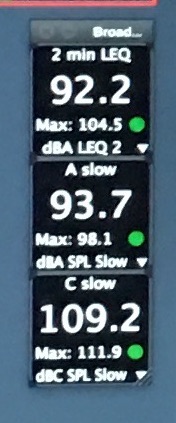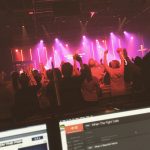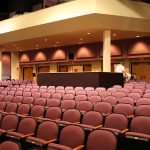
A to C
I don’t talk about SPL that much because I typically don’t like talking about it. Measuring SPL has its uses, but I find it gets way more attention than it’s due. If you didn’t catch my Not a Number article from a few years back, I suggest you read that before diving into this.
Now that you’re caught up, I wanted to show you something I found interesting. I’ve been doing fly dates mixing down in Florida at some of Christ Fellowship’s campuses on a somewhat regular basis this year, and this caught my eye in a photo I snapped during the music on a recent Sunday. It was a pretty good Sunday in terms of the mix balance so I thought this might be illustrative for some of you.
The SPL I mix at for CF varies a bit from campus to campus because the rooms are all different, the PA’s are all different, the bands are all different, and consequently it feels a little different everywhere. At this particular campus I’d say that 95 dBA is probably about as high as I run things on the loud and fast songs in a room that seats probably around 1500 people.
From a numbers perspective that is a bit lower than I ran things when I was on staff at North Point, but I would say perceptually it doesn’t feel that much quieter. When I was at North Point I used to say we were on the lower edge of concert-level volume, and I’d put CF just shy of that, although sometimes they go there, too. Most importantly, the level feels right in the room for the room, the band, and the people attending at CF. But I digress.

Here’s what I wanted to show you. The latest version of Smaart–version 8–now lets you display multiple SPL measurements which you can see here. I like the feature because it provides some interesting perspectives on SPL.
First up is an A weighted LEQ. I like using an LEQ for music due to music’s dynamic content. An LEQ is basically an averaging over a certain amount of time which gives you an EQuivalent measurement to constant noise which is what all the hearing conservation listings are based on. So an LEQ over 10 minutes is the equivalent of a measure of 10 minutes of steady noise like you might find in a factory with machinery constantly running.
I typically use 2 minutes for my LEQ which is about half a song’s length. Smaart’s default is 10 minutes which is often used for noise measurements. The problem, though, is the longer you go with an LEQ, the longer it takes for you to get any usable data on where you’re at. If I used a 10 minute measurement in churches, the music set would be almost over before I had any data. With a 2 minute measurement, by the time I hit the second chorus I usually have a good read on how loud that song is and can make adjustments if necessary. If I was mixing a concert the longer measurement might be handy, but within a service I like the 2 minutes to have an idea of how loud each song is.
Next we have our A weighted slow which is sort of the standard SPL measurement. I’ve used this more than anything so I can get some meaningful information out of it if my mixes are in my normal ballpark. Most of my clients also speak in terms of A weighted slow so I always have this going.
Finally, we have C weighted slow. I started playing with C slow because that’s what they use for movie theaters, and I’ve been liking watching that for video content in order to compare it to a theatrical experience. I was also curious about the actual difference between an A and C measurements because I’ve seen frequent discussions around the interweb that are often ill-informed regarding the two measurements.
If you’re unfamiliar with the difference between A and C weightings, A focuses more on the midrange while C tends to be flatter and wider in bandwidth. An A weighted measurement doesn’t factor low frequency content into the measurement. A weighted is favored when measuring for hearing conversation since it’s the mid-rangey stuff that tends to be more damaging and painful. OSHA and NiOSH standards in the US for occupational hearing conservation all use A weighted measurements, and since the standards all use A weighted measurements, that’s what I primarily use.
All that said, take a look at the difference between the A and C measurements. For the math challenged, that’s a 15.5 dB difference. This illustrates a big reason why I don’t like using C measurements for live music: C weighted numbers can FREAK PEOPLE OUT! I don’t know what it is, but to the casual observer three digits in an SPL measurement is bad.
Another reason I don’t like C weighted measurements is because people don’t understand the difference between it and A weightings and often apply OSHA’s A weighted standards to C weighted measurements. So let’s say I’m running 93.7 dB C-weighted slow instead. Based on the data in this one measurement here, I would estimate the A weighted equivalent is around 78-79 dBA. City traffic is usually louder than that. Plus this level isn’t much louder than where most people run their speech level at which I find is typically in the low to mid-70’s dBA. Obviously, one piece of data isn’t enough to really start making conclusions, but based on my experiences I feel confident in this conclusion.
Now, an 80 dBA’ish level might be just right for your church; I don’t know because I’m not there. However, I would be skeptical you’re reaching your full potential for impact and engagement if you’re trying to do modern Hillsong/Elevation/Passion/Bethel type music. But my point in this article isn’t to tell you how loud you should run your service. You need to figure that out for yourself and not by looking at where everyone else is at.
The point I want you to get is it’s important to understand the difference between SPL weightings because different weightings will give you widely differing results.
My recommendation is to always use A weighted because that’s what hearing conservation standards use and A-weighted numbers are what most people think and speak in terms of. Volume complaints have been very rare for me over the last several years because, as I’m sure I’ve written about before, loudness has more to do with musical content and frequency balance than a single SPL number can ever tell you, and I work very hard to provide balanced mixes. SPL measurements can still be a useful tool, though, but if you’re going to use them make sure you understand what you’re measuring and why.

 Previous Post
Previous Post Next Post
Next Post


